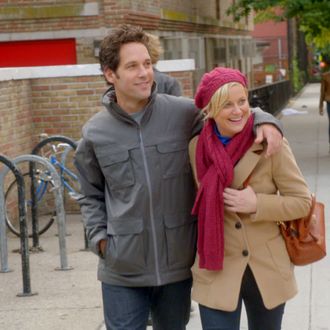How Do I Explain Why This Is Funny
Explaining the Funny, Then Not Funny, Then Funny Again Joke

There's a scene in the rom-com parody They Came Together that goes likethis:
Bartender: "You look like you've had a badday."
Paul Rudd: "You can say thatagain."
Bartender: "Well, you came in here looking like crap and you haven't said verymuch."
Rudd: "Tell me aboutit."
Bartender: "Well, you came in here looking like crap and you haven't said verymuch."
Rudd: "You can say thatagain."
Bartender: "Well, you came in here looking like crap and you haven't said verymuch."
Rudd: "Tell me aboutit."
… and this repeats, like, eight more times. Hat tip to the Globe and Mail for transcribing the bartender bit, and as that paper's film critic points out, this is one of those scenes that starts off funny, half-pivots to tiresome, and then, somehow, swings another 180 degrees back to funny. It's hard to resist; even if you don't entirely want to reward the tedious gag with a laugh, you probably do. Behold the power of what we will heretofore refer to as "long-joke," for lack of an actual, establishedterm.
So, while it's true that nothing is less funny than trying to explain why a joke is funny, it's still worth asking: What makes the long-joke work? "It's a puzzling question," said Peter McGraw, a humor researcher and co-author of the recent book The Humor Code: A Global Search for What Makes Things Funny. McGraw said that while he couldn't recall any studies that examine this phenomenon specifically, it does remind him of his own research on comedy and timing. In a paper recently published in Social Psychological and Personality Science that tested the classic saying, "tragedy plus time equals comedy," McGraw and his colleagues used tweets about Hurricane Sandy to plug some numbers into that equation: Fifteen days was too soon, 99 days was too long, but 36 days was justright.
And the spirit behind that finding could easily transfer to the long-joke, McGraw said. "The passage of time helps make humor more benign, and less threatening. But the further passage of time just makes it more benign," he said. "It takes a situation that's kind of normal, a fairly typical scene in the movie. And what it does is it starts to create a violation — it starts to make the situation uncomfortably awkward. And I think it's that awkwardness, that discomfort, that is actually the root source of a lot of what we findfunny."
And at the moment, the scene becomes uncomfortable, McGraw explains, "what ends up happening is there's this sort of meta thing, where you recognize that this is being done purposefully as a joke, rather than something that's supposed to mirror reallife."
When the long-joke works, it could also be thanks to a second comedy equation: the Rule of Threes — the idea that jokes are funniest when there are no more or no fewer than two repetitions preceding the punch line, Jyotsna Vaid, a psychologist at Texas A&M who studies humor, said in an email to Science of Us. "We found support for this idea but only when each repetition involved a progressive incremental shift in meaning," Vaid said in an email. "When the repetition did not involve any progression in meaning or intensity, we found that jokes with three repetitions before the punchline were actually judged funnier than those with two repetitions. Long jokes would seem to be an extreme case of this lattertype."
I'm not a big Family Guy fan, but I've seen enough of it to know that this is a well-worn device that the show's writers use. Comedy expert Vaid rated this "mildlyamusing":
Another, and I would argue funnier, version of this comedic device is this Tig Notaro bit, wherein she drags a stool across the floor, for two and a half minutes straight. That's it. That's the entire bit. Shh, justwatch:
McGraw also points out that Andy Kaufman did this back in the '70s, and, to my 9-year-old mind, the epitome of high humor was this scene from Monty Python and the Holy Grail. (Vaid, for what it's worth, didn't find the latter at all amusing.) At any rate, there may be a case to be made for an additional humor equation: absurdity plus tedium also equalscomedy.
Source: https://www.thecut.com/2014/07/funny-then-not-funny-then-funny-again-joke.html
0 Response to "How Do I Explain Why This Is Funny"
Post a Comment